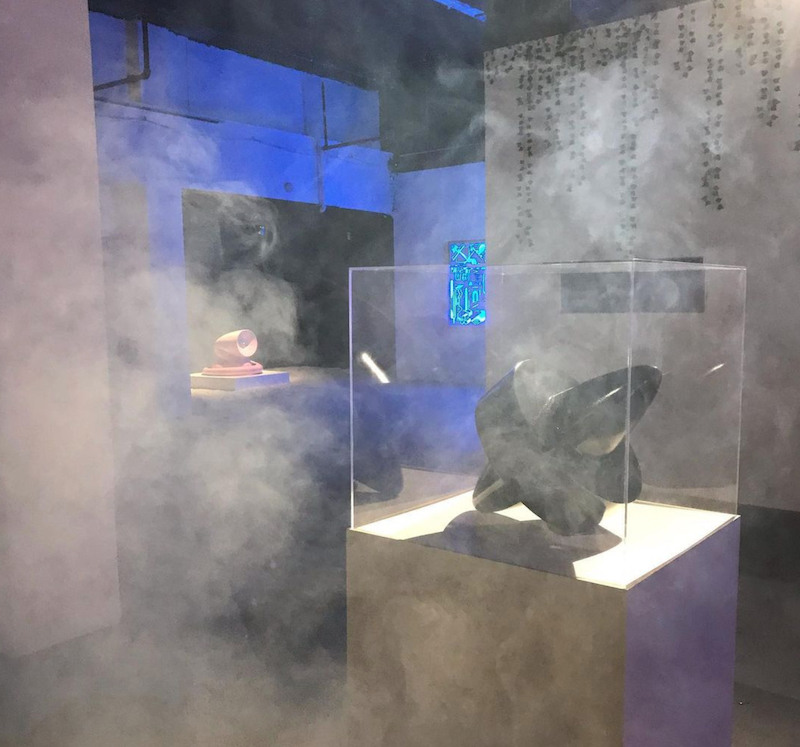
By Sandra Abbott and Leon Lai
What was on view: This ICA solo exhibit by Eduardo Corral is the fifth in his TLaloC series, in which he mines the writings of Argentine writer Jorge Louis Borges. Located in part of what was a former bowling alley, a current storage space, and a dank basement never before seen by the public, it features 40,000 square feet of art ranging from traditionally framed vector renderings and figural sculptures in museum vitrines to inflatables at the scale of Macy’s Thanksgiving Parade balloons. The installation spaces are large enough to fill an NBA basketball court. Lots of fog machines, stairs, sketchy pathways, and dim lighting are involved, so fair warning–it’s not a particularly accessible space.

Installation shot, Orbis Tertius -Hlaer-to-Jangr- at ICA Baltimore. Photo: Sandra Abbott.
Orbis Tertius -Hlaer-to-Jangr-
Open Hours: By appointment only. Contact ICA to arrange a visit.
Dates: May 14 – June 13, 2021
Artist: TLaloC, aka Eduardo Corral
Online: https://icabaltimore.org/
ICA Gallery
16 West North Avenue
Baltimore, MD 21218
FaceBook Twitter
Tumblr Instagram
Sandra: So is this the first time you’ve been to an ICA exhibit?
Leon: Yes.
Sandra: The Institute for Contemporary Art Baltimore (ICA) is an all-volunteer organization. They give solo exhibitions to emerging and mid-career artists. They’ve been at different locations over the years, and I hear this is the last time they’ll be exhibiting in this ginormous, multi-level space here at 16 West North Ave.
Leon: How do you feel about the show?
Sandra: You know how when you’re really hungry and you eat a potato chip and you think it’s the best potato chip—no, the best food you’ve ever tasted? That’s what I was wondering about this exhibition. Because of the pandemic, it’s been so long since I’ve been out to a show—especially an all-immersive gesamtkunstwerk that spans a full city block. Am I just really excited to see art in person, or was this truly a great show?
Leon: I think it was a great show. However, I prefer to call it an adventure rather than a show, especially when we took that personal tour with the director, Lou Joseph. He led us around the whole building. I never expected a show like this. It was beyond my imagination.
Sandra: Yeah, it really was an adventure. In some ways it had more in common with a visit to an amusement park funhouse or a theme park. The overall effect reminded me of my favorite Disney attraction, the Haunted Mansion. At the Mansion, you start out looking at conventional portraits on the walls, but as the room (really, just a giant elevator) descends, the portraits expand at their bottoms to reveal bizarre and unexpected imagery. It’s not so much threatening as it is as little tense and strange, but sublime and wonder-filled too.
Like the Mansion, the show started out relatively normal—with a couple of traditional gallery spaces containing museum vitrines showcasing smaller sculptures and nicely-framed digital prints on the walls. Things really started to get strange, however, as we transitioned into that huge back room.
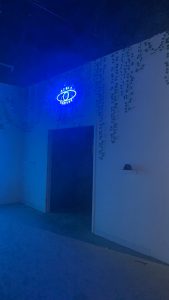
Installation shot, Orbis Tertius -Hlaer-to-Jangr- at ICA Baltimore. Photo: Sandra Abbott.
I noticed over the door to it there was a neon sign with the show’s title, “Orbis Tertius” with a subtext underneath, “Hlaer-to-Jangr.” According to the handout we received, the show explores manifestations of native Tlön symbols. Tlön is a fantastical and elusive land conjured in Borges’s, Uqbar, Orbis Tertius and other writings. As we passed through that doorway to the mysterious land of Tlön, the gallery show gave way to an immersive installation. I felt a strong shift in atmosphere as we moved to the next room with the fog machines spewing a thicker soup and that ominous music was really booming.
Leon: Exactly. The sound contributed a lot to the show. It took the audience into a mood step by step as we entered the deep of the second room. The atmosphere collapsed around us. Everything over there was messy and the dust was everywhere. However, I think TLaloC deliberately did this. He wanted the audiences to feel uncertain and chaotic. The decoration matched the theme and the style of the show. He turned off all the lights in the room. The only light sources were coming from the works themselves. That made all sculptures obvious and stunning.
Sandra: Yes! That second room was so crazy! It had a War of the Worlds feel to it for me. I found evidence of that in the far corner. There was that black inflatable orb, the size of a Volkswagen with metallic spikes protruding from it. It looked like something that crashed in Area 51 back in 1950. The atmosphere was so dark and smokey from those fog machines I was worried an alien would emerge any moment from that craft. And I was hoping this wasn’t going to become a performance piece as well.

Installation shot, Orbis Tertius -Hlaer-to-Jangr- at ICA Baltimore. Photo: Leon Lai
Leon: That’s right and that’s what I mean “step by step”: TLaloC sets up everything. In the beginning, everything was as traditional as other shows. He is Mexican, right??
Sandra: Yes. And he takes his moniker from the ancient Mexican rain god, Tlolac, which may also be a character from Jorge Louis Borges’s writings.
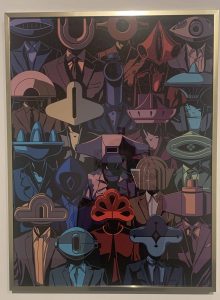
La Compañía (The Company) 2018, digital print. Photo: Sandra Abbott.
Leon: Those paintings near the front door were reflecting the South American style of drawing. The lines were thick, the colors were saturated, and the composition doesn’t have a singular focal point. Those features remind me of the pre-Columbian art style. Also, those images featured divinities, similar to pre-Columbian art works, which always have a strong connection to the gods. Once we entered the second room, the atmosphere immediately turned “upside down”. And then, we went to the most impressive and astonishing part of the show, the basement.
For me, my first impression of the first part of the basement is dark and suffocating. It looks like we don’t have anywhere to escape. The whole place was sealed. The chair in the middle stood out. It left me lots of space to wonder why it is here. It makes me feel creepy, such as somebody just being interrogating on the chair right before we entered.

Basement installation, Orbis Tertius -Hlaer-to-Jangr- at ICA Baltimore. Photo: Leon Lai
Sandra: OMG, the Basement! The creepiest part for me was seeing those otherworldly inflatables and glowing lights through the wire cages. We saw the big red inflatable that way. It fell to its side like a discarded toy of a giant child. The form echoed those seen in the 2D and 3D work of the first gallery.
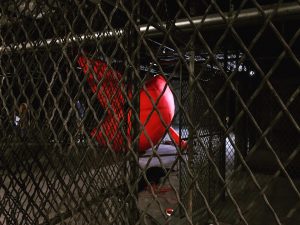
Basement installation, Orbis Tertius -Hlaer-to-Jangr- at ICA Baltimore. Photo: Leon Lai
Amidst the dilapidated building, which provided the dystopian futuristic backdrop, there was some gorgeous, colorful imagery glowing from lightbox drawings on the walls of the dimly-lit basement. The light box drawings showed similar shapes as those seen in the projected animations upstairs. These drawings depicted objects that reminded me of 1980s Memphis Group designs with their bright, punchy colors and the even spacing of their repeating patterns. Some of those sculptures upstairs looked like they might be at home on an Ettore Sottsass étagère. The small, colorful wall mounted sculptures, just like the inflatables, look like plastic toys or fantastical machine parts Willy Wonka from Ronald Dahl’s Charlie and the Chocolate Factory might have used. This is when you and I had that discussion that began, “Did you ever see that film series, ‘Saw’?”
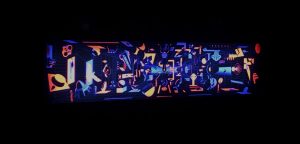
Ficciones No.4 Control -BRUTALIST SERIES-, Orbis Tertius -Hlaer-to-Jangr- at ICA Baltimore. Photo: Leon Lai
Leon: The movie series has too much dismembering and blood. However, I want to talk about the art design of the film. No matter which episode of the series, the materials to make those tools and maze always contain rotten metal. It is disgusting, dirty and dangerous. As well as here. Once we walked into the space, I can tell it was uncomfortable if we stayed here longer. The set created by TLaloC wasn’t only visually impacting me, but also mentally traumatized me.
Sandra: Following Lou again, we eventually wound our way through some precarious hallways and up two steep flights of stairs. (I thought I was going to die from cardiac arrest after being pandemic-sedentary for so many months.) At the top of the stairs I was bopped on the head by a hanging extension cord plug before I fixed my gaze on the room beyond. The music and fog continued. As my eyes adjusted I could make out a slim figure in the distance with a geometric form instead of a head. It was reminiscent of the sculpture and one of the images in the 2D work, La Compañía that we saw in the first gallery.
That’s what I like about this gesamtkunstwerk, or total work of art. Everything relates to something else. You can see the DNA from this mystical Borges/TLaloC world run through every form, every image. It’s very cohesive, very well-resolved. I like that.

Second floor installation, Orbis Tertius -Hlaer-to-Jangr- at ICA Baltimore. Photo: Leon Lai
Leon: Actually, I think the second floor wasn’t breath holding compared to the basement. I felt released from a cage or prison. And you’re right, the figure is too special. The fog machine was next to it. The figure was standing in the fog. It felt like the spaceship just landed on Earth. The alien came out of the spaceship and ready to meet with human beings or any other creatures in this land. The set is very superstitious and ritualistic.
Sandra: What a contrast that traditional “white box” art gallery that we first entered was to the places we went to beyond it. I really felt disoriented when we exited the building on a different street than the one we entered. It was if we worm-holed to a different part of the city or universe or had traveled through time.
When I turned to the gallery handout for help, it asked us if we could “confirm if that place was real, if this TLaloC really exists or if it was all an illusion.” What do you think? Does he really exist? Is this a real place, or did we imagine that experience?
Leon: I try to leave it in the air. I don’t want to explain or seek an answer to that. I would lose the feeling I had when I left the gallery if I continue to over obsess with this question. This adventure was unique. I am just wondering when I might experience something like this again.
Sandra: Let’s hope it’s soon.
TLaloc
TLaloC, aka Eduardo Corral, is an interdisciplinary artist, award-winning illustrator, graphic designer, and educator born in the industrial city of Monterrey, Mexico. He has participated in 40+ collective international exhibitions (in México, China, Germany, Colombia, USA, among other countries) and four solo exhibitions. Among other projects and distinctions, he designed the Trophy Award of the inaugural SPOTIFY Awards in 2020. He has won Gold and Silver awards in Latin American Design Awards (LAD Awards) in 2019 and 2020 respectively. He was selected winner of the 01 (2018) and 02 (2020) PICTOLINE Illustration Biennial in Latin America. He was a selected winner for Society of Illustrators 62 and 63 UNCOMMISIONED SHOW/SOI128 and “Chosen winner” for American Illustration 38 AI-AP. He has been selected as the winner at AI-AP (American Illustration/American Photography) – Latin American Ilustración 2, TR3S, 4, 5, 6, 7, and 8 consecutively, and also in the itinerant exhibition “Los Diez” (Orensanz N.Y. Foundation). He holds an MFA in Illustration from the Maryland Institute College of Art (MICA) and was a recipient of the Fulbright Scholarship, granted by Fulbright Comexus-García Robles Program for Studies Abroad. He currently works as a full-time professor in the First Year Experience department at MICA.
ICA Baltimore – icabaltimore.org
ICA Baltimore is a collaboration of volunteers working to stage contemporary art exhibitions in available spaces in Baltimore. Orbis Tertius -Hlaer-to-Jangr- is the thirty-third exhibition by the ICA since 2011, and the final exhibition in our gallery at the North Ave Market.